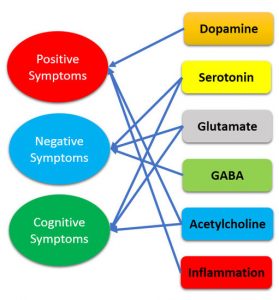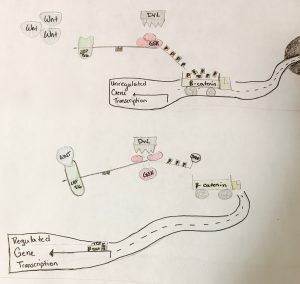
The Story of Schizophrenia
With symptoms ranging from quietness to experiencing hallucinations or delusions, schizophrenia is a mental health illness that is difficult to diagnose and difficult to biologically analyze. Generally, the symptoms of schizophrenia are manifested in individuals who are in their late teens to early twenties, but brain development before being born can cause varying susceptibility to the disorder.

It is thought that certain messenger chemicals in the brain (neurotransmitters) causing an imbalance of communication between neurons play a large role in the development of schizophrenia. The image below represents the hypothesized neurotransmitters/pathways responsible for the three classes of symptoms seen in schizophrenia: positive, negative, and cognitive.

Certain drug treatments target or act with these neurotransmitters to alleviate symptoms of the disorder. One example of this is a drug that blocks the receptor that dopamine (a neurotransmitter) would normally bind to. How would this help alleviate symptoms? After dopamine is bound to it’s receptor, Wnt, a signaling pathway in the brain can’t function properly. The final affect of this inhibited signaling is gene expression that is improperly regulated.

Artstract: The story of Wnt. This image depicts the Wnt signaling pathway including two scenarios, one with Wnt ligand binding and one without binding. Wnt binding is implicated in regulated gene transcription through TCF/LEF mediated transcription.
This is not a specific picture of schizophrenia, but does help to explain the large variety of symptoms and irregularities seen in the brains of individuals diagnosed with the disorder.
The unfortunate truth for schizophrenia is that there is still a long way to go before the full mechanism of the disorder is understood. For now, there is no real way to “cure” schizophrenia, and treatment options focus on alleviating the symptoms of faulty brain wiring, and hopefully leading to a more manageable and independent life. In future research, exploring treatment options including the Wnt signaling molecules as target cells could provide some relief from the wide range of symptoms. Overall, more understanding of specific mechanisms detailing the schizophrenia story is needed to truly unpack how the disorder is manifested and experienced.
References/Further research
- https://www.nimh.nih.gov/health/topics/schizophrenia/index.shtml
- https://www.placesforpeople.org/hear-our-voices/
- http://www.mentalhealthamerica.net/conditions/schizophrenia
- https://youtu.be/6Qpl-3eR6eE
- https://www.placesforpeople.org/hear-our-voices/
WARNING: If you or your family have a history of mental illnesses or vertigo, we strongly advise that you DO NOT participate in this simulation as it could potentially trigger those illnesses to begin.
Image References
- https://progress.im/en/content/dopamine-synthesis-common-factor-genetic-and-environmental-risks-schizophrenia
- https://www.inspiremalibu.com/blog/drug-addiction/schizophrenia-and-the-risks-of-substance-abuse/
- https://www.mdpi.com/1422-0067/18/8/1689/htm